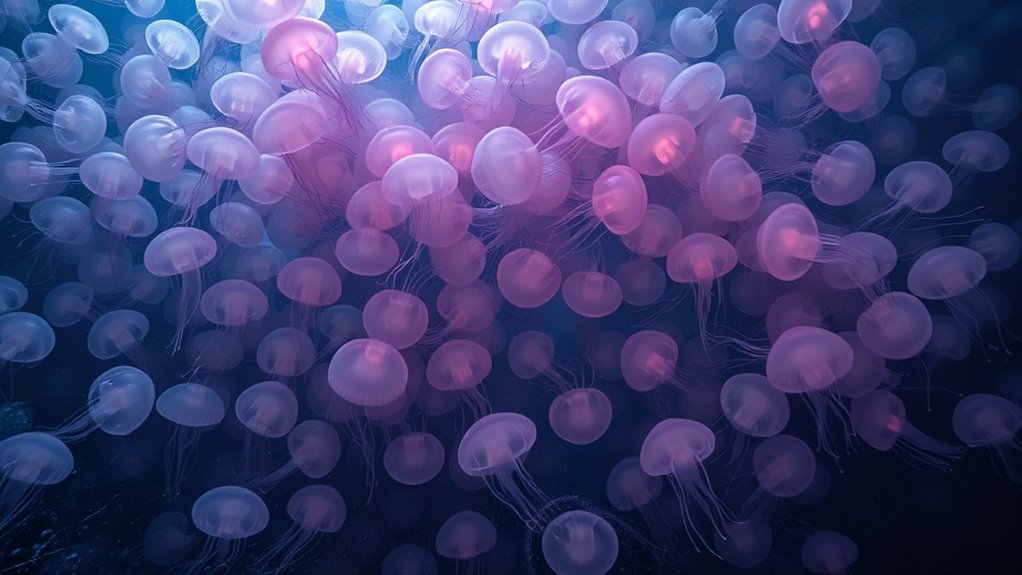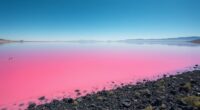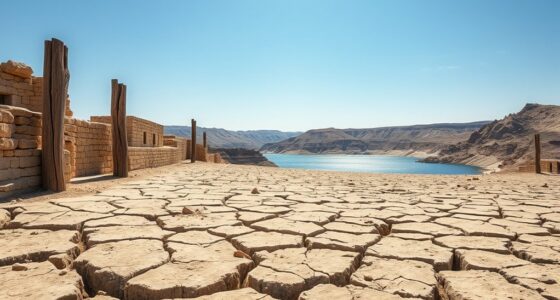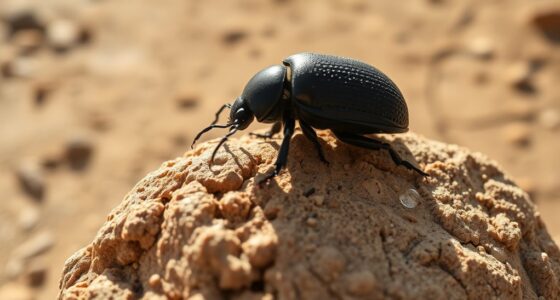Human activities like overfishing and climate change are creating the perfect ocean storm for jellyfish blooms. Overfishing reduces predator populations, allowing jellyfish to multiply unchecked, while rising sea temperatures from climate change expand their habitats. These combined factors disrupt marine ecosystems and threaten biodiversity. If you want to understand how our actions are fueling these massive blooms and what you can do to help, keep exploring the factors behind this fascinating phenomenon.
Key Takeaways
- Climate change and rising sea temperatures create ideal conditions for jellyfish proliferation.
- Overfishing reduces predator populations, allowing jellyfish to multiply unchecked.
- Ocean stratification and ecosystem disruptions from human activities enhance jellyfish habitats.
- Melting ice caps and storm activity expand jellyfish-friendly environments globally.
- Human-induced factors collectively contribute to creating a “perfect storm” for jellyfish blooms.
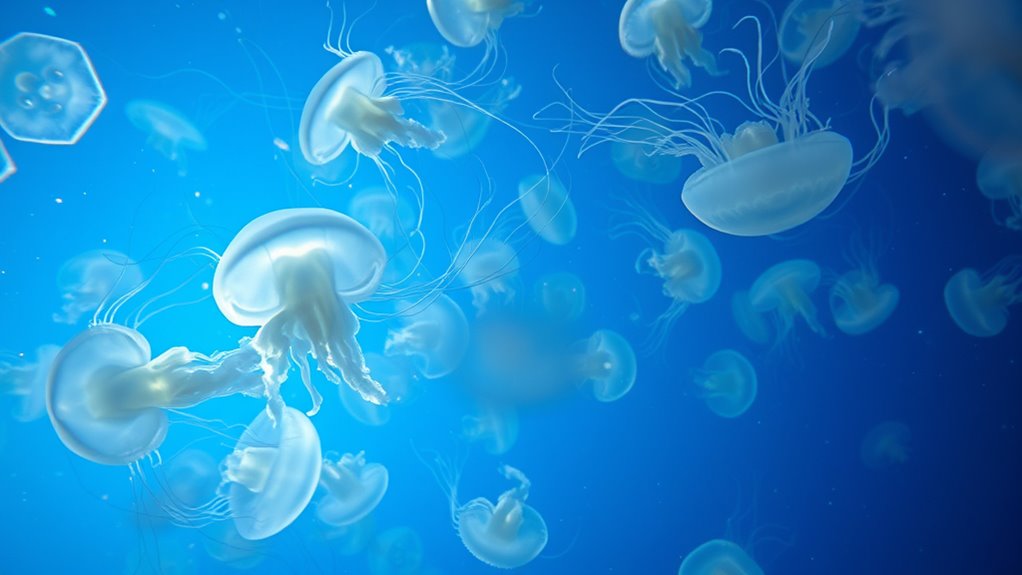
Jellyfish blooms are appearing more frequently and in larger numbers, posing significant challenges for marine ecosystems and human activities alike. As you observe these massive swarms drifting through our oceans, it’s clear that multiple factors are fueling their rise. Two key contributors are climate change and overfishing, both of which disrupt the delicate balance of marine life and create the perfect conditions for jellyfish proliferation.
Climate change plays a major role in this phenomenon. Rising sea temperatures alter ocean currents and stratify the water layers, creating ideal environments for jellyfish to thrive. Warmer waters often lead to increased plankton populations, which serve as the primary food source for jellyfish. With more food available, jellyfish can reproduce rapidly, leading to large blooms. Additionally, the melting of polar ice caps and increased storm activity further disturb ecosystems, allowing jellyfish to colonize new areas that were previously unsuitable. These changes don’t just make life easier for jellyfish—they also threaten the balance of entire marine communities, impacting fish populations and other species that rely on the same food sources. Maintaining ecosystem balance is crucial for preventing uncontrolled jellyfish growth.
Rising sea temperatures and melting ice caps boost jellyfish blooms, disrupting marine ecosystems and food chains.
Overfishing compounds the problem. When human fishing practices remove key predator species and competitors, jellyfish face fewer natural controls. Many fish and invertebrates feed on jellyfish or compete with them for resources, but overfishing diminishes these populations, giving jellyfish free rein to expand unchecked. The decline of predator species, such as certain types of fish and sea turtles, means jellyfish are less likely to be kept in check naturally. This imbalance accelerates bloom occurrences, sometimes leading to massive swarms that can clog fishing gear, damage boats, and even block out sunlight from reaching underwater habitats.
Your interactions and the choices you make as a consumer and policy advocate influence these dynamics. Overfishing is driven largely by demand for seafood, and climate change is driven by greenhouse gas emissions from human activities. By addressing these issues—reducing overfishing through sustainable practices and lowering carbon footprints—you can help mitigate some of the conditions that favor jellyfish blooms. It’s not just about saving jellyfish; it’s about protecting the complex web of life in our oceans, which ultimately sustains human life as well.
The more you understand how climate change and overfishing create a perfect storm for jellyfish, the better equipped you are to advocate for solutions. Whether it’s supporting sustainable fishing policies or reducing your carbon emissions, your actions can contribute to restoring balance and resilience in marine environments. The rise of jellyfish blooms signals deeper problems beneath the surface—problems that demand your awareness and action.
Frequently Asked Questions
How Do Jellyfish Blooms Affect Commercial Fishing Industries?
You might notice that jellyfish blooms impact commercial fishing by causing bycatch issues, where fishermen unintentionally catch jellyfish instead of target species. This reduces the catch of valuable fish and can damage fishing gear. Additionally, jellyfish blooms contribute to fish stock depletion by competing for plankton, the main food source, leading to lower fish populations. These effects strain the industry and threaten sustainable fishing practices.
Can Jellyfish Blooms Be Entirely Eradicated or Prevented?
You can’t entirely eradicate or prevent jellyfish blooms, but you can manage them. Biological controls, like introducing natural predators, might help, yet they’re risky and could disrupt ecosystems. Chemical interventions are an option but often harmful to marine life and the environment. Instead, focus on reducing nutrient runoff and overfishing, which fuel blooms. Your best bet is a balanced approach combining these strategies to limit bloom intensity and frequency.
What Role Do Climate Change and Ocean Warming Play in Jellyfish Proliferation?
Climate change and ocean warming markedly impact jellyfish proliferation. As temperatures rise, you’ll notice more favorable conditions for jellyfish reproduction and survival. Warming oceans also cause climate feedbacks like altered currents and nutrient flows, boosting blooms. Additionally, ocean acidification weakens predator and competitor populations, giving jellyfish an advantage. These changes create a perfect storm, making jellyfish blooms more frequent and intense, affecting marine ecosystems and human activities alike.
Are Jellyfish Blooms Harmful to Human Health or Safety?
Jellyfish blooms can pose risks to human health and safety. When you encounter a bloom, you might get stung by jellyfish venom, which can cause pain, skin irritation, or allergic reactions. These human stings are often accidental, especially in swimming areas. It is crucial to stay alert and avoid touching jellyfish to prevent harmful stings, as their venom can sometimes be severe, even requiring medical attention.
How Do Jellyfish Blooms Impact Local Ecosystems and Biodiversity?
You see, jellyfish blooms can dramatically disrupt local ecosystems and biodiversity. They outcompete plankton, choking crucial food sources, and alter predator-prey dynamics by overwhelming fish populations and other predators. This creates a cascade of consequences, destabilizing the delicate balance of marine life. As jellyfish proliferate, they threaten the health of the entire ecosystem, making it harder for diverse species to thrive and survive in their natural habitats.
Conclusion
If we don’t change our ways, we’re stirring up a perfect storm in the ocean’s dance floor. Like a wildfire spreading unchecked, jellyfish blooms can overrun ecosystems, choking out other marine life. Your actions—pollution, overfishing, climate change—are the sparks fueling this chaos. To prevent a future where the ocean’s balance is shattered, it’s up to you to make smarter choices. Together, we can turn the tide before the storm is unstoppable.
